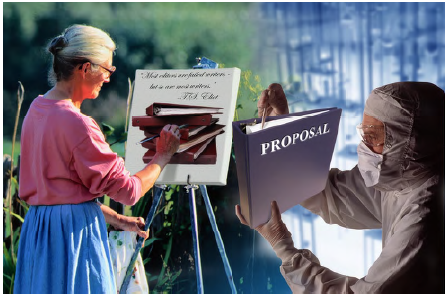
The Art and Science of Writing a Proposal Masterpiece
Anyone can write— or at least put words to paper. Writing effectively to communicate ideas in a convincing, compelling, and persuasive way is another matter. The most talented and successful writers combine the analytic components of writing (the science) with the emotional components of writing (the art) to create masterpiece proposals that position them to win.
The general lack of writing skills in the business community has created thousands of writing, editing, desktop publishing, and related jobs in the Washington, D.C., area alone. Most of the professionals filling these positions have extensive experience and writing skills that are sufficiently persuasive for their work. However, even the most accomplished writers can benefit from refreshing their technical skills (the science of writing), or developing a more sophisticated approach to some of the less analytical and more emotional elements (the art of writing).
Persuasive Proposal Writing as a Science
Most people can improve their proposal writing skills by learning the science of writing and by following some simple rules. These rules are well established and well documented. A Google search on “writing persuasive proposals” the day I wrote this article yielded 11.7 million hits. My experience writing winning proposals, highly acclaimed articles and speeches, websites and brochures, and most recently a book, has made writing second nature for me. Spending an entire day talking about the science of writing in a training class or workshop is easy. Developing an effective article on persuasive writing is a challenge I couldn’t resist. I sat down with a blank screen and developed the following list of common sense proposal writing tips. These capture the essence of proposal writing as a science for me. Perhaps they will help you to become a more persuasive writer:
- Organize and outline. Develop an annotated outline to organize your thoughts. Stay within the high-level structure defined by your customers. Don’t be afraid to change lower-level sections and sub-sections to make your story more persuasive.
- Brainstorm and prioritize. Brainstorm, prioritize, and sort your ideas in a simple way that is easy for you to communicate and for your audience to digest. Research topics if you need more benefits, features, or proof points. Package these into manageable chunks (target 3-5 per topic area).
- Put the reader first and the author second. Put yourself in the reader’s shoes by thinking about reader benefits first. Support each benefit with the related features you want to communicate, and the supporting proof points for each feature.
- Begin with the end. Carefully construct benefit/feature theme statements to start paragraphs that align with the outline. Start with conclusions, overview, or recommendations first. Follow these summary statements with the supporting detail for each major point you make. Weave in customer hot buttons and competitive
intelligence if possible to make your points more relevant and compelling. - Don’t underestimate visual appeal. Use white space, bullet points, bolding, and graphics to emphasize important concepts or take-away points.
- Write for your mother-in-law. It is highly unlikely that the reader of your persuasive proposal knows more about your subject than you do. Use simple
words and short sentences. Write as if you were trying to educate or persuade your mother-in-law (10th grade level target). Avoid technical jargon that only a subject matter expert with a Ph.D. would understand. - Clean house. Get rid of all unsubstantiated claims, clichés, jargon, and technical gobbledygook. Some passive language may be acceptable depending on the context.
- Dare to be different. Decide how to best make your proposal stand out in the crowd. Use grabbers, closers, clinchers, analogies, and rhetorical questions to get the reader’s attention. Don’t be afraid to be creative and courageous to make your points.
- Use the tools. Use spellchecker and MS Word readability statistics. Compare your readability scores against target benchmarks that are right for your audience. Here are some of the actual statistics for this article compared to my benchmark targets: –– 14.1 words/sentence (target <20) –– 1% passive voice (target <5%) –– 49.9 Flesch Reading Ease (target >40.0) –– 9.8 Flesch-Kincaid Reading Level (target 9-11.9)
- Let it sit like a fine wine. Let your proposal prose sit for a while by taking a break after the first draft. Look for ways to improve readability (see #9), edit, then edit again. Ask someone with a sophisticated writing/editing palate to “taste it” before making it available for general consumption.
Persuasive Proposal Writing as an Art
Once you have learned the rules and mastered the science of writing, you are well on your way to becoming a truly elite persuasive writer. However, the art of persuasive writing requires an entirely different set of skills and abilities that are difficult, and for some people, virtually impossible to learn.
We are complex, emotional beings. Persuasion is as much about logic (the mind) as it is about emotion (the heart and soul). The most persuasive writers carefully consider things like the word choice, tempo, and the rhythm of their narratives. They capture the attention and imagination of readers by using analogies and stories to get the emotional response they seek.
The art of a classical musical performance and the art of persuasive writing share a common goal – connecting the audience with the artist. Ludwig van Beethoven connected with his audiences in his famous classical Symphony No. 5 in C Minor (Beethoven’s 5th). Connecting with an audience is also about the timing and duration of your masterpiece. Many writers mistakenly believe that more content is better than less. They pack their works with long-winded narratives that force-feed readers with useless information. Their audience is left feeling bloated, dazed, and overstuffed.
Some of the most persuasive artists (musicians and writers alike) practice the Japanese principal of hara hachi bu. In Japanese, hara hachi bu means “eat until you are 80 percent full.” This concept of moderation applies to most things in life.
The audience at the premiere performance of Beethoven’s 5th in Vienna was reportedly exhausted by the length of his work. Whether he knew it or not, Beethoven used the concept of hara hachi bu and cut his original score to the perfect length for his audience to digest. Think about the art, the science, and hara hachi
bu to make the next thing you write a masterpiece.
 It’s Not Easy
It’s Not Easy
Writers almost universally agree that writing is rarely easy—even for full-time professionals. Presented in the table to the right, a high-level chronology provides some insight into the timing and activities that went into this simple article over a threeday period.



